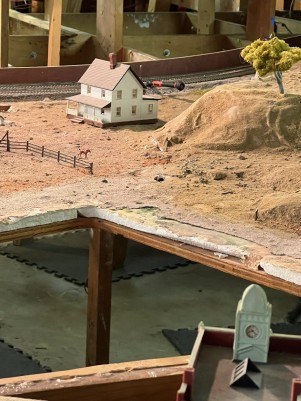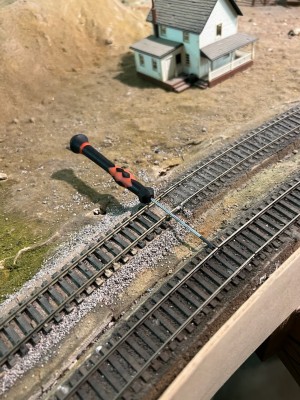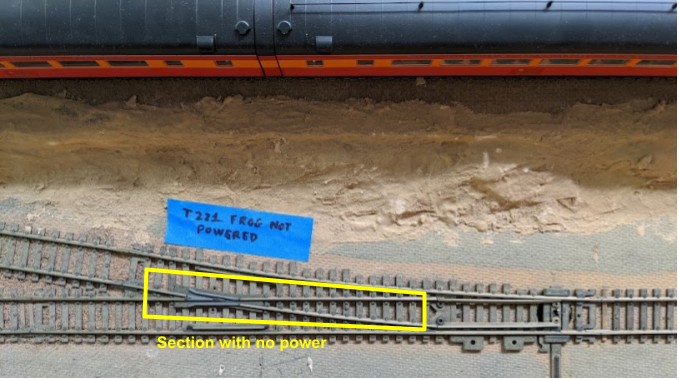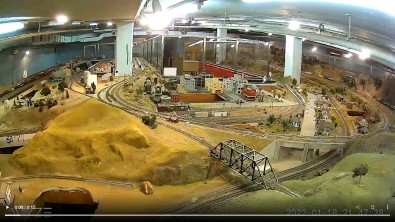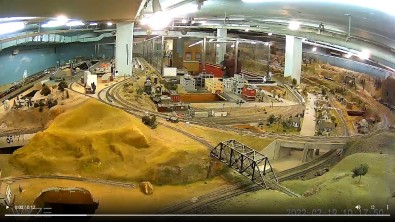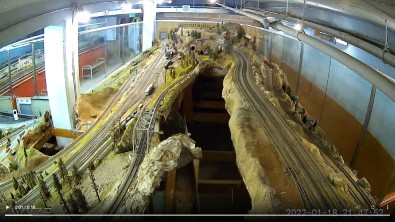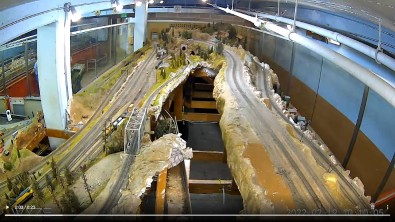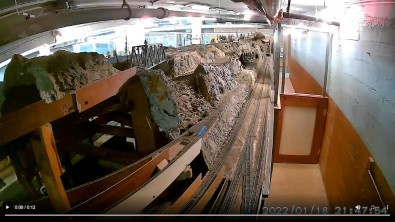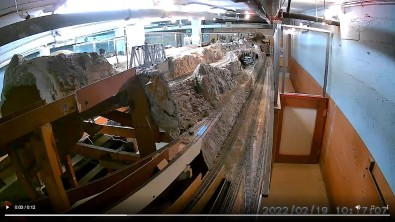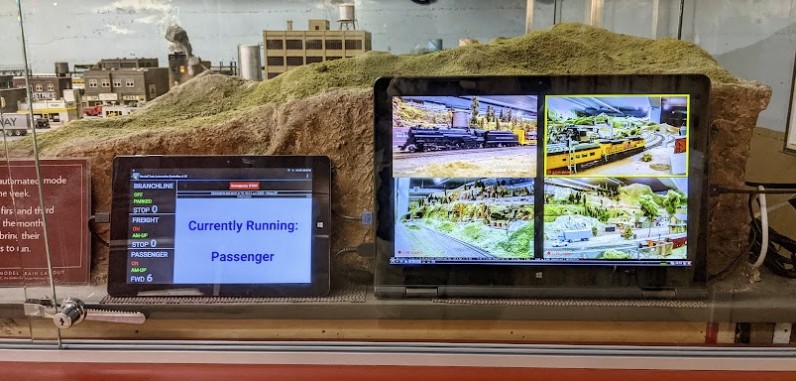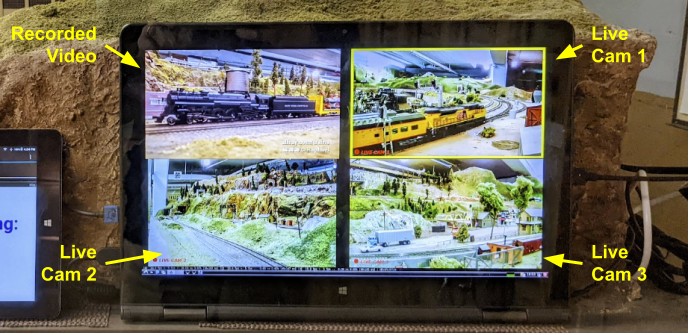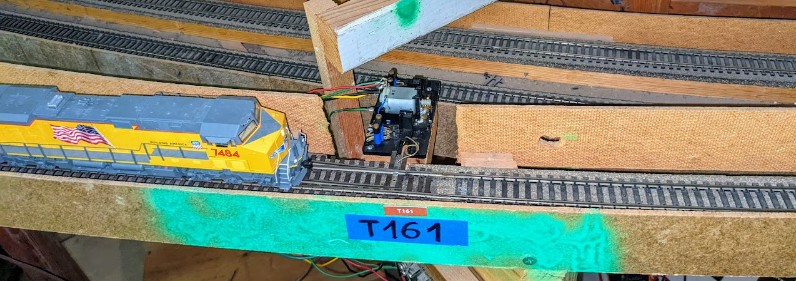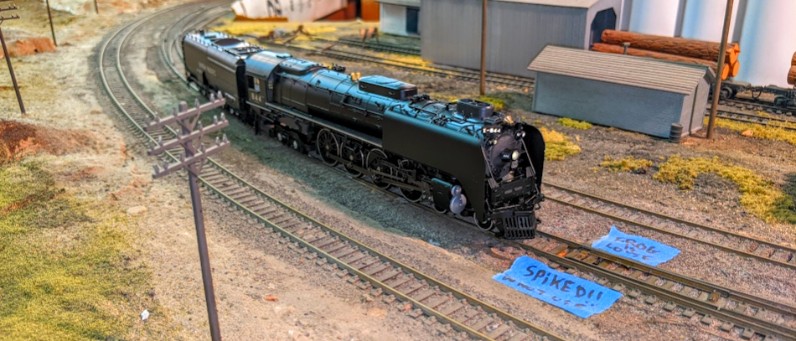The Randall Museum in San Francisco hosts a large HO-scale model railroad. Created by the Golden Gate Model Railroad Club starting in 1961, the layout was donated to the Museum in 2015. Since then I have started automatizing trains running on the layout. I am also the model railroad maintainer. This blog describes various updates on the Randall Museum Model Railroad and I maintain a separate tech blog for all my electronics & software not directly related to Randall.
Affected |
Turnout T840 on Branchline (Smith Flats towards Gravel Pit). |
Description |
Throw switch rod doesn’t close. Track out of gauge. |
Summary Fix |
Spike throw switch rod in place. |
Description of Issue
We have been trying to run MoPac #153 on the Branchline in automation. It failed on T840, which is just outside of the canyon tunnel leading to Smith Flats / Bear River section on the Branchline. The engine was running in reverse direction when the car & tender followed the track yet the steam engine went straight through the turnout:
The issue is even more clear from an aerial picture shot:
Click here to continue reading...
2022-03-27 - Update
Category RandallRecently I have been exploring my latest DIY experiment: a homemade “dead spot detection car”.
Click here to read the corresponding post for more details on this contraption.
Not a lot has been happening lately, at least nothing visible. I did an update on the Raspberry Pi controlling the automation wifi network, and I also revived one of the wyze cams that had gone unresponsive and offline again.
Finally I’ve been revisiting my plans to add more block detection on the Branchline as I plan to tackle that project shortly -- there’s a lot of planning that goes upfront here, and it starts by poring over the pictures of the electrical connection terminals, and trying to guess or decipher what is and isn’t there. I detected some inconsistencies in my Branchline track schematics.
We have two spots on the layout where we have experienced episodic dead spots -- loss of track power that seems to fix itself. I suspect some rail or solder contact that works or doesn’t work based on the temperature and humidity. I’ve fixed a couple of these and each time I need to experience the dead spot to figure where it originated from. It’s hard to fix something when that thing just plain works.
Yesterday, a new such spot appeared, at block B100 between Lodi and Fairfield. Allen was able to work around by bridging the gap between B90 and B100 using a screwdriver, thus powering B100 from B90:
I’m a big fan of such creative workaround to keep running.
We closely examined the track today, and identified the block boundaries. Unfortunately there was no dead spot today, the track was working fine, and we found no culprit to this issue. There’s a track feed a couple feet before, and the solder joints seem sturdy and nothing breaks when the track is flexed or the wires are jiggled around -- a proven rigorous scientific approach to identify such issues.
We also examined some other spots where we have had engines stop-and-go on specific turnouts. I posit some have to be due to resistance from the powered frog contacts on the switch machines. However measuring a few spots revealed nothing useful. It did not help that today engines were not hesitating on these spots either.
It’s quite annoying when everything works, ironic, isn’t it?
Later, we looked at a known issue with engines losing power when crossing turnout T221. Looking at it and testing it with the voltmeter, it became quite obvious:
The entire frog is unpowered on this turnout -- everything in the middle “X” part till the two round pivot joints. The closure rails (the ones that move) seem powered only by contact with the stock rails. There’s also no sign of any power pick up anywhere on this turnout. It’s really entirely unpowered. That means most trains stop on this turnout unless they have multiple units, or long wheelbase engines such as these long SD70s.
The turnout looks to me to be an Atlas turnout, due to the typical two tabs next to the throw bar. On Atlas turnouts, these two tabs with their little middle hole are used to attach a side twin-coil turnout machine.
If we wanted to fix this, we would have to power the frog and the inner closure rails. To do that, the twin-coil switch machine under the layout already has the contacts that can control the frog power but we’d need to pick up power from the stock rails, and somehow solder the “outgoing” power feed to the frog. Many turnouts have solder points on the underside to create such connections, and obviously here we’d have to do it from the top. It’s some work but it’s definitely doable.
A quick search on powering frog on Atlas turnouts indicates the frog is “pot metal” and won’t take any solder, however there are holes next to it just for that purpose and one would make contact by using a “2-56 screw” in there. An indeed there are two holes right next to that frog:
Some work has been made on the string of fluorescent lighting on the sides of the room. The two strings of ceiling fluorescent tubes with their 60s-era ballasts on both sides of the room had all mostly failed over the last four years, rendering the two side alleys quite gloomy.
All the credit goes to Chris, Director of Randall Museum, who performed all the work on his own, independently of our regular volunteer maintenance work.
A month ago |
Today |
It’s notably better over Stockton Yard and the middle of the mountain area -- the before/after pictures don’t quite express the stark difference since the cameras obviously compensate for overall luminosity, however it’s quite clear there are a lot more shadow areas on the before pictures.
Affected |
Turnout T161 (end of siding between Bridgeport & Sultan). |
Description |
Intermittent loss of power on frog. |
Summary Fix |
Add bond wires to power turnout stock rails from B161. |
Description of Issue
For a while we’ve had issues with the turnout T161. Trains would stop dead on the turnout. Other times they worked fine. Some trains could go through just fine yet we would have issues with steam engines.
Back in 2018, I identified the frog power showed a clear resistance, and posited it was due to faulty contacts in the Fulgurex. After changing the switch machine in 2018, the problem went away. Then since last year we’ve had intermittent issues again with this.
Two weeks ago, I did two things. First I hardwired the turnout for the straight route. Now the frog is always powered directly from the proper stock rail. The switch machine contacts powering the frog are entirely bypassed. The other thing I did is take an overhead picture of a similar turnout and color the rails to clearly understand the power routing of the turnout.
The “fix” from two weeks ago did not last long. At the next operating session, trains stopped on the turnout again. However this is good as it helped eliminate the Fulgurex as the culprit. It is not an issue of frog power routing. We also know that the turnout sometimes works fine, so I suspect a bad solder join or something similar on the way the turnout gets its power, something that varies with time & temperature as the track can expand or shrink -- a problem we have in a few other locations on the layout.
Here’s a picture of T161:
And here’s the same picture, annotated to understand power routing:
Now I understand how this all works:
Click here to continue reading...
Now for something a bit different… understanding power routing on turnouts as used at Randall on the mainline.
This replies to a question I had recently, and eventually I’ll add it to the Randall Layout documentation because it’s good for future reference. Once again I was tempted to write here an explanation of why turnouts are wired the way they are, yet that would be long and convoluted. For that, I’ll just refer to the excellent material at https://dccwiki.com/Turnout which is complete with detailed schematics and presents the various ways a turnout can be wired.
For our mainline turnouts, here’s a concrete example by taking an overhead shot of Turnout T05 and coloring the rails A and B and all the parts which are electrified the same way:
Turnout straight/normal.
Turnout thrown/diverging.
Non-isolating power routing turnout:
For reference, this style is called a Non-Isolating Power Routing Turnout: the entirety of the frog and the closure rails are one contiguous section and are all powered depending on the position of the turnout. Two wires bring power from both rails A and B into the switch machine and a contact moves to select power from either rail A or B and powers the frog and the connected closure rails accordingly.
Click here to continue reading...
The original Vision computer is back on the layout, running the latest version of the vision software:
I had issues with that Lenovo Yoga 15 at the end of last year and I quickly exchanged it for a smaller X1 I had as a spare at home. I’m glad to be able to have the Yoga 15 back on the layout as the screen is larger, and it’s also the most ridiculously good looking screen I’ve seen on a Lenovo line so far. Super sharp, rich in color and contrast. It really shines in this video display application. I don’t want to diss my beloved Lenovo X1 screen, it’s just that the X1 screen is matte and really works well for work and long coding sessions, whereas the Yoga screen is more vivid in color and obviously targeted more at displaying videos.
Here’s a description of the display when running the vision software:
On the picture, Live Cam 1 has a yellow highlight around the video to indicate that motion has been detected in this live video stream, and we can indeed see the yellow UP passenger train in view.
Eventually I want to move the cameras 2 & 3 to more interesting parts of the layout, yet before I can do that I’m waiting for the museum’s maintenance staff to fix the overhead lighting issue.
The interesting thing is that overall we use 60% of the CPU on this machine (Lenovo Yoga 15 with i5-5200U @ 2.2 GHz):
Affected |
Turnout T161 (end of siding between Bridgeport & Sultan). |
Description |
Intermittent loss of power on frog. |
Summary Fix |
Bypass the frog polarity contact/inverter. Deactivate turnout (always straight). |
Description of Issue
Back in 2018, we had engines stop-and-go on turnout T161 for quite a while, especially steam engines, or short non-MU engines. The turnout was always in the normal position when this happened. Back then, it was determined the frog power routing on the Fulgurex created a resistance. This was solved in 2018-12-12 by replacing the Fulgurex. The issue re-appeared last year, and it was “fixed” by Allen spiking the frog in place. This worked for a while, and now the issue is reappearing again, with trains going dead on the frog.
Frog issue: Issue is frog power via the Fulgurex contacts. Last time, it was solved by swapping the Fulgurex. Eventually the contracts just oxidize or present some kind of resistance, likely to complete lack of use. And we cannot throw that turnout since the throw bar has been spiked.
Click here to continue reading...
We’re having a “dead spot” problem at turnout T161. Again. For the 3rd time.
I was going to ramble at length on the complexities of turnout designs and what causes them to short. Instead I’ve decided to skip that because https://dccwiki.com/Turnout has much better graphics, and better explanations. So please go read that.
One thing I do not know for sure is what kind of turnouts are installed at Randall. I should know. And document it.
Click here to continue reading...
Affected |
Turnout T111 (after Fairfield station, arriving at Lodi). |
Description |
Point loose. Specific steam engines derailing.. |
Summary Fix |
Spike/glue the point. |
Description of Issue
We’ve had some specific steam engines derail here in the past. It was identified the point rails were loose because there is no turnout throw rod at all. Previously the point rails were spiked.
We recently were having problems again with some specific engines, this time being this BLI 844 Challenger. The suspicion was that the spike may have been too high and derailed the engine.
Click here to continue reading...



